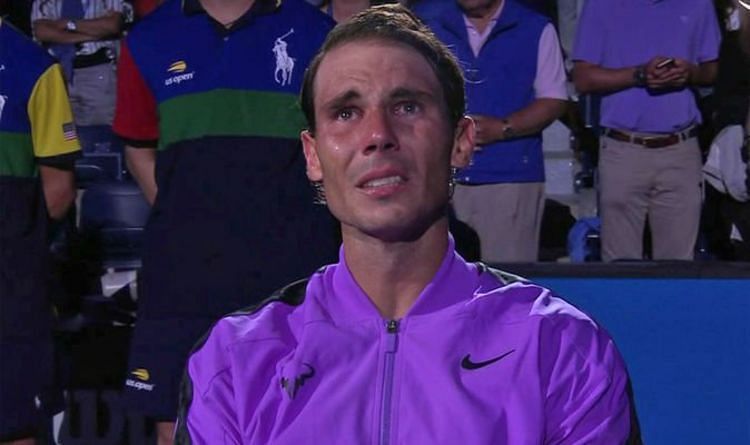
US Open: A walk down Nadal's illustrious journey at Flushing Meadows

Rafael Nadal sealed a hard-fought five-set win over first-time Grand Slam finalist Daniil Medvedev to win his fourth US Open title last Sunday.
On seeing a video grab of his 18 previous Grand Slam titles in the post-match presentation, Nadal let loose his pent-up emotions and shed a few tears, as the enormity of the occasion dawned on the Spaniard.
These were tears of pure unadulterated joy as Nadal ruminated about recovering from debilitating knee injures, and early losses against lesser-ranked opponents at a Grand Slam tournament where the Spaniard took nine years to reach his first title match.
Nadal has had his fair share of struggles at the US Open since debuting as a seventeen-year-old in 2003, where he beat American qualifier Alex Kim in straight sets in the first-round before Moroccan Younes El Aynaoui brought an end to the Spanish teenager's campaign.
The next year, Nadal survived a five-set encounter against Swiss qualifier Ivo Hueberger before losing to American Andy Roddick in straight sets in the second round. It would be three more years and two Grand Slam titles (2005-06 Roland Garros) since his US Open debut that Nadal managed to crack the second week in New York.
In 2006, the Spanish left-hander arrived in his first US Open quarterfinal and first last-eight clash in a hard-court Grand Slam, following successive straight-set wins over Mark Philippoussis, Luis Horna, Wesley Moodie and Jiří Novák respectively before falling to Russian Mikhail Youzhny in four sets.
First US Open semifinal
Two more years and three more Grand Slam titles (2007-08 Roland Garros and 2008 Wimbledon) later, newly crowned world no. 1 Nadal beat American Mardy Fish in the quarterfinals to reach his first semifinal at Flushing Meadows.
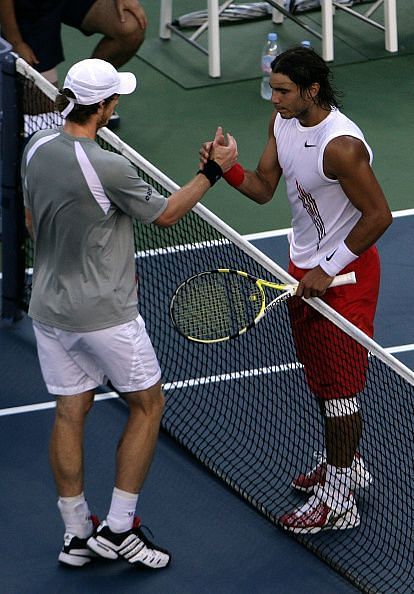
In a rain-delayed last-four clash, the top seed fell to first-time Grand Slam semifinalist Andy Murray in four sets, which thwarted a first-ever meeting with his arch-rival Roger Federer at the US Open.
A year later, Nadal suffered his third defeat in a Grand Slam semifinal and second at Flushing Meadows when 20-year-old Argentinian Juan Martin Del Potro overwhelmed the Spaniard for the loss of two games in each set to hand the then five-time Grand Slam champion one of his most lopsided defeats.
First US Open final and the first title
In his ninth appearance at Flushing Meadows, Nadal avenged his 2007 quarterfinal defeat to Mikhail Youzhny by beating the Russian in straight sets in the semifinals to arrive in his first US Open final.
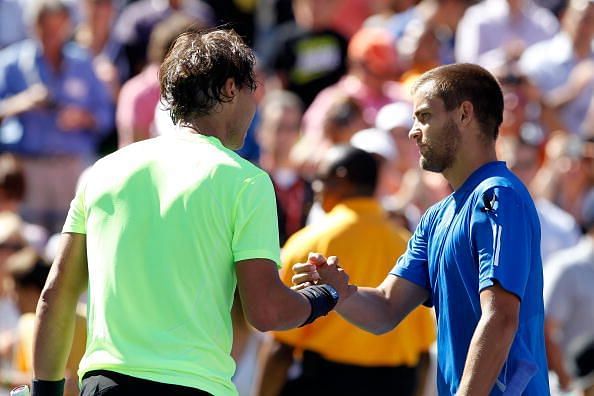
It was the longest Nadal took to reach a Grand Slam final, after reaching the title matches at the Australian Open, Roland Garros and Wimbledon in his 5th, 1st and 3rd campaigns respectively.
After winning the first set against Djokovic in the final, Nadal was two-thirds of his way towards emulating Neale Fraser (1960) by winning his first US Open without dropping a set.
But Djokovic was made of sterner stuff and ensured the match would go at least four sets by grabbing a late break en route to taking the second set. Nadal survived the Serb's onslaught in the third set to take a two sets to one lead and sealed his first title at the US Open by conceding just a game in the fourth as Djokovic ran out of steam.
With the win, Nadal extended his Grand Slam head-to-head and tournament final record against Djokovic to 5-0 as the Spaniard became the fourth player in the Open Era, after Rod Laver, Andre Agassi, and Roger Federer, to win all four Grand Slam tournaments. Nadal also emulated Laver by becoming the second player in the Open Era to win three consecutive Grand Slam titles in the same season.
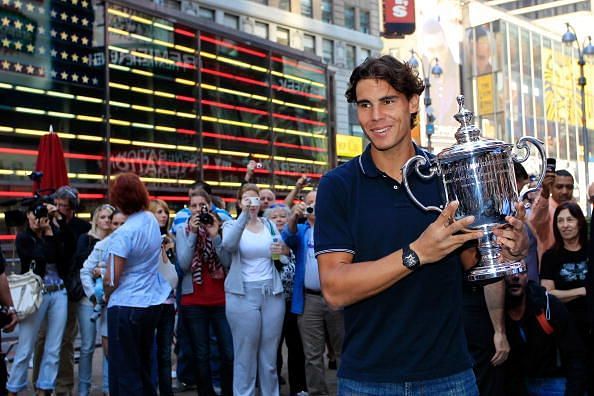
Second US Open final
In 2011, Nadal racked up consecutive straight-set wins over Golubev, Mahut, Nalbandian, Müller, and Roddick to arrive in his fourth US Open semifinal in as many years. In the last-four, Nadal avenged his 2008 last-four defeat to Murray by beating the Scot in four sets, to return to his second US Open final in as many years.
The Spaniard faced his newest nemesis Djokovic across the net. In his sixth tournament final meeting with the Serb in 2011, Nadal was determined for a reversal of fortunes after losing finals at Indian Wells, Miami, Madrid, Rome, and Wimbledon earlier in the season.
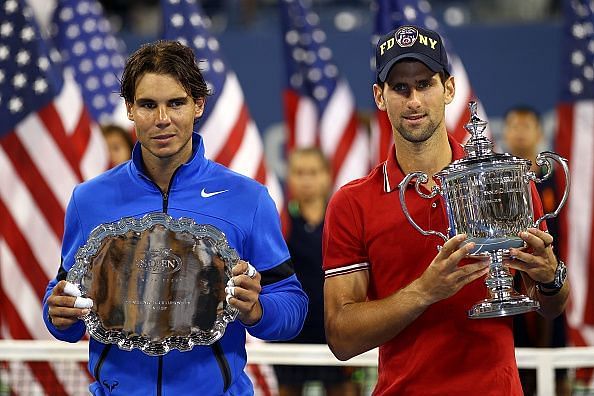
But it was Djokovic who sprang out of the blocks and took a two-set lead for the loss of just six games before Nadal responded by taking the third set in a tiebreak. The defending champion's momentum would be short-lived though, as Djokovic took the fourth set 6-1 to close out a four-set win for his first title at Flushing Meadows.
Second US Open title
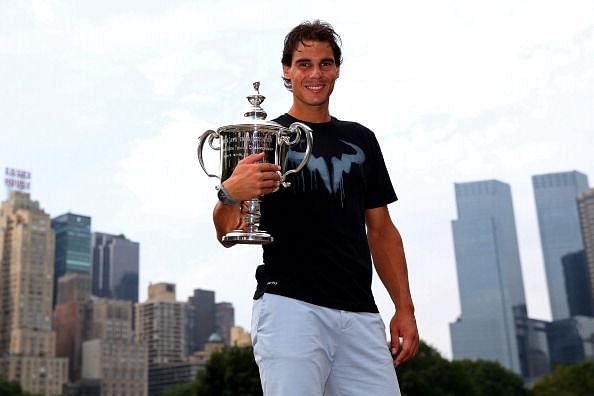
After missing the 2012 edition of the tournament due to injury, Nadal beat Federer's conqueror Tommy Robredo for the loss of just four games in the quarterfinals and beat Frenchman Gasquet in straight sets in the semifinals to reach his third final at US Open where familiar opponent Djokovic lay in wait.
It was Nadal who made the brisker start in the pair's third US Open final, as the Spaniard rode on two breaks of the Djokovic serve to take the opening set. The 2011 champion responded by thrice breaking the Nadal serve in the second set to restore parity.
Nadal was reeling under the onslaught of Djokovic's forehand as the Spaniard went down an early break in the third and was a point away from conceding a double break. But the Spaniard dug deep to hold serve and as Djokovic's level plummetted, the Spaniard recouped the break to get back on serve at three games all. At 4-4 Nadal found himself under the gun as he fell behind 0-40, but Djokovic failed to get the break which would prove crucial as the Spaniard broke the Serb in the next game to steal a two-sets-to-one lead.
Djokovic disintegrated after the loss of the third set in which he was the better player for large swathes. Nadal capitalised on his opponent's lapse to close out a 6-2 3-6 6-4 6-1 for his second title at Flushing Meadows and 13th Grand Slam title.
A spate of early exits
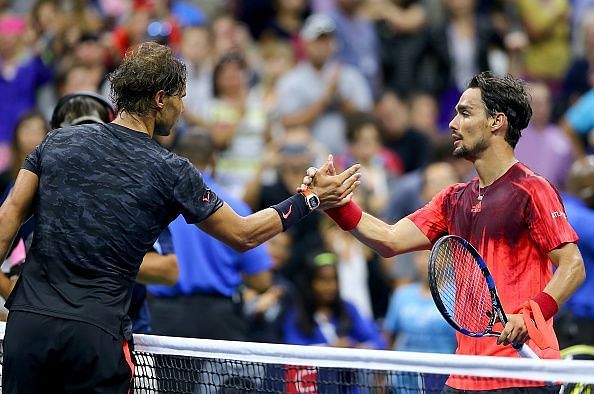
After missing the 2014 US Open due to a recurring knee injury, Nadal launched his 12th campaign at Flushing Meadows with victories over Borna Coric and Diego Schwartzman.
In his eighth meeting with Italian Fabio Fognini, Nadal made a bright start and looked on course for a routine straight-set win in the third round when the Spaniard led by two sets and a break in the third. Fognini seemed to momentarily delay the inevitable by taking five of the last six games to take the third set.
Trailing two-sets-to-one, the Italian faced an uphill task against Nadal who had never lost a Grand Slam match on 152 previous occasions after taking a two-set lead. Fognini struggled to rein in his unforced errors but produced more winners than errors to take the match to a pulsating decider where Fognini thrice led by a break, only for Nadal to break back each time at the first time of asking.
Fognini's heavy-hitting forced a fourth break of the Nadal serve in the fifth set and the Spaniard was powerless to retrieve the break as the Italian held serve to record one of the finest wins of his career en-route to his first fourth round at the US Open.
Defeat to Fognini ended Nadal's record of winning a Grand Slam for ten consecutive years.
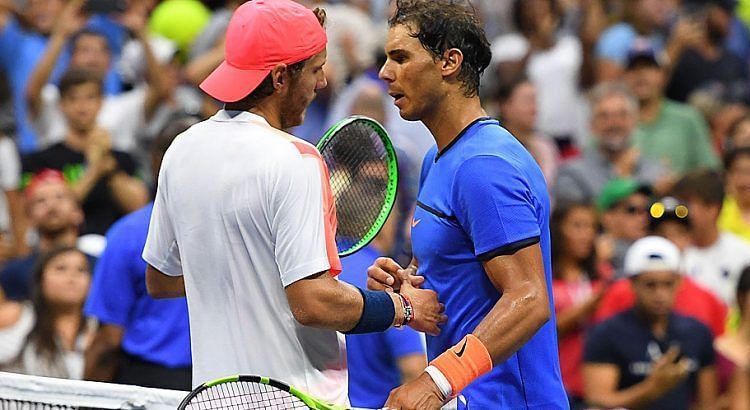
2016 marked the second consecutive year when Nadal failed to triumph at his beloved Roland Garros. The Spaniard looked to end a difficult year on a positive note when he arrived in the US Open fourth-round following successive three straight-set wins over Denis Istomin, Andreas Seppi, and Andrey Kuznetsov respectively.
In the pair's lone previous meeting, Nadal beat Lucas Pouille in the 2015 Monte Carlo first-round. But it was Pouille who made the stronger start in the fourth-round clash in New York, romping to a one-set lead for the loss of just one game. Nadal responded by taking the second set 6-2 but fell behind two sets to one when the Frenchman captured the third set 6-4.
It was the first time at the US Open, Nadal trailed by two sets to one. The Spaniard launched his comeback by winning the fourth set 6-3 and looked good for a victory when he led 4-2 in the fifth. But Pouille fought back to get back on serve to force a deciding set tiebreak.
Nadal looked to be the favourite to close out the victory, owing to his superior big-match pedigree, but it was Pouille who converted his fourth match-point to oust the Spaniard and win his third consecutive five-set match at Flushing Meadows.
It marked the first time since 2004 that Nadal failed to reach the quarterfinals at a major.
Third US Open title
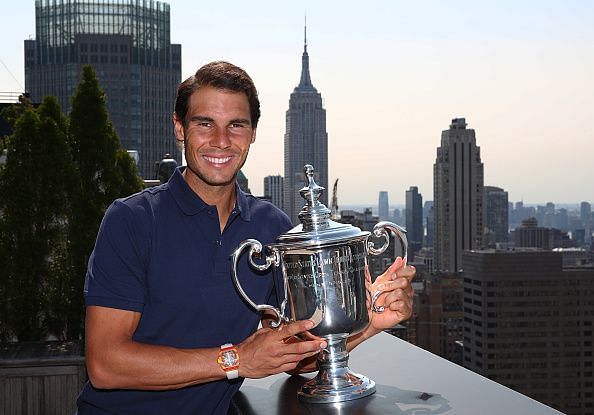
Following a five-set loss to his long-time rival Roger Federer at the 2017 Australian Open, Nadal ended his three-year Grand Slam drought by winning his tenth title at the French Open for his 15th career singles Grand Slam title.
Nadal arrived at the last Grand Slam tournament of the year as the world's top-ranked player. The Spaniard beat Alexandr Dolgopolov and first-time Grand Slam quarter-finalist Andrey Rublev to reach his first semi-final at the US Open in four years where he faced 2009 champion, Del Potro. The Argentinian had thwarted a first-ever Federer-Nadal match-up at Flushing Meadows by beating the Swiss in a four-set last-eight clash, a result which allowed Nadal to hold on to his No. 1 ranking.
In his first US Open meeting with Juan Martin Del Potro since being allowed just six games in the 2009 semi-finals by the eventual champion, Nadal was not in the mood for a repeat result as he beat the Argentinian in four sets to move into his first US Open final since 2013.
In fourth title match at Flushing Meadows, Nadal overwhelmed first-time Grand Slam finalist Kevin Anderson of South Africa in straight sets to win his first hard-court title in almost four years, a third US Open title and his 16th Grand Slam.
Nadal's victory marked the first time since 2010 that the duo of Federer and Nadal swept all four Grand Slam titles in the calendar.
Fourth US Open title
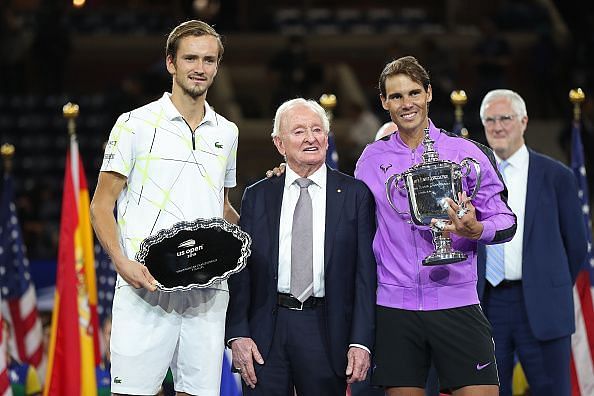
A year after retiring in the semi-finals against Del Potro, Nadal was the overwhelming favourite in his fifth US Open final against first-time Grand Slam finalist Daniil Medvedev of Russia, following the early exits of Djokovic and Federer.
The Spaniard had conceded just three games in his only previous meeting with Medvedev in the Coupe Rogers final in Montreal earlier in the season but it was Medvedev who made the brisker start in the final, breaking Nadal for a 2-1 lead.
However, Medvedev failed to consolidate the break and Nadal was back on serve at two games all. Nadal squandered three break points but maintained relentless pressure on the Medvedev serve to break in the twelfth game and take a one-set lead.
Medvedev extricated himself out of a 0-40 hole in the fourth game of the second set to hold serve but Nadal came good on his fifth break point to take a 4-2 lead. It was a lead the Spaniard would not relinquish en route to a commanding two-set lead.
In 138 previous editions of the tournament, only one player had recovered from a two-set deficit to win the final, when Pancho Gonzalez triumphed against Ted Schroeder (16-18 2-6 6-1 6-2 6-4) in the 1949 title match.
Nadal moved to within three holds of a straight-set win when he broke Medvedev for a 3-2 lead in the third. But the Russian's response was prompt as he got back on serve in the next game. Medvedev held for a 6-5 lead and powered a blistering forehand winner set up three consecutive set points. Nadal saved the first with a serve-and-volley but was powerless to save the second as Medvedev reduced the arrears to two sets to one.
In a competitive fourth set, with Nadal serving to stay in it at 4-5, the Spaniard's forehand misfired to give Medvedev a set point which the Russian gleefully accepted with a brilliant backhand return winner as the Flushing Meadows title match went the distance for the first time in seven years. In the process, Medvedev became the first player after Federer (2008 Wimbledon) to recover from a two-set deficit against Nadal in a major final and force a fifth set.
Medvedev rode his momentum to hold serve in the opening game of the fifth and rued squandering three breakpoints on the Nadal serve as the Spaniard broke for a 3-2 lead. The three-time champion promptly consolidated the break broke Medvedev for a second time in the set to take a seemingly insurmountable 5-2 lead.
The final, though, had more twists in store as Medvedev broke back for 3-5 and saved two championship points to hold for 4-5. Serving for the championship for the second time, Nadal conceded the first point of the game and narrowly avoided falling behind 0-30 when Medvedev hesitated to go for a volley at the net.
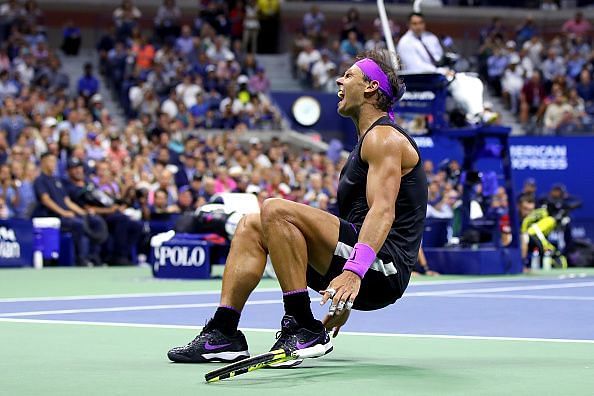
Nadal struggled to land enough first serves and survived a break point on a second serve. Two points later, the Spaniard collapsed to the ground in ecstasy after sealing the toughest victory of his US Open career to win his fourth title at the tournament.